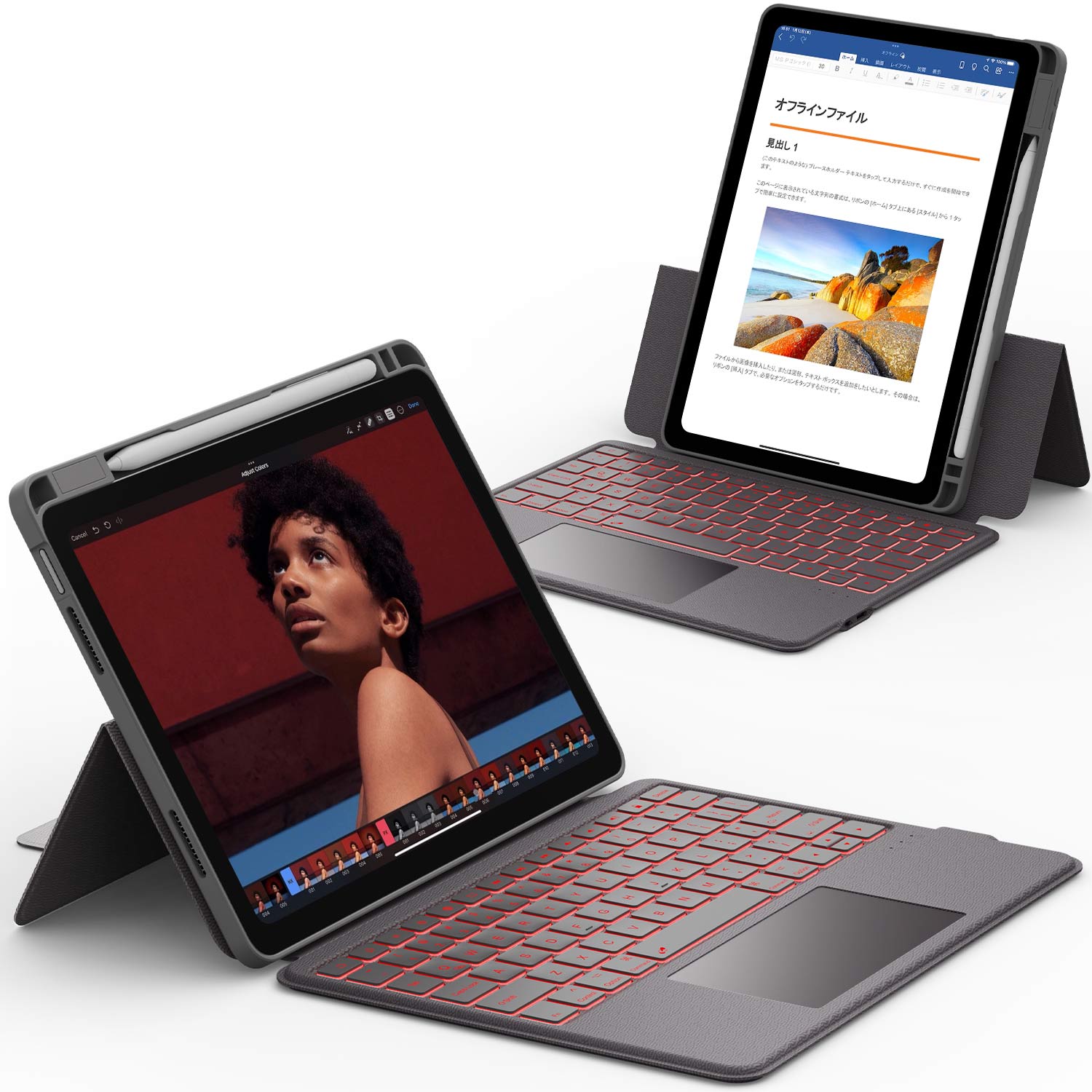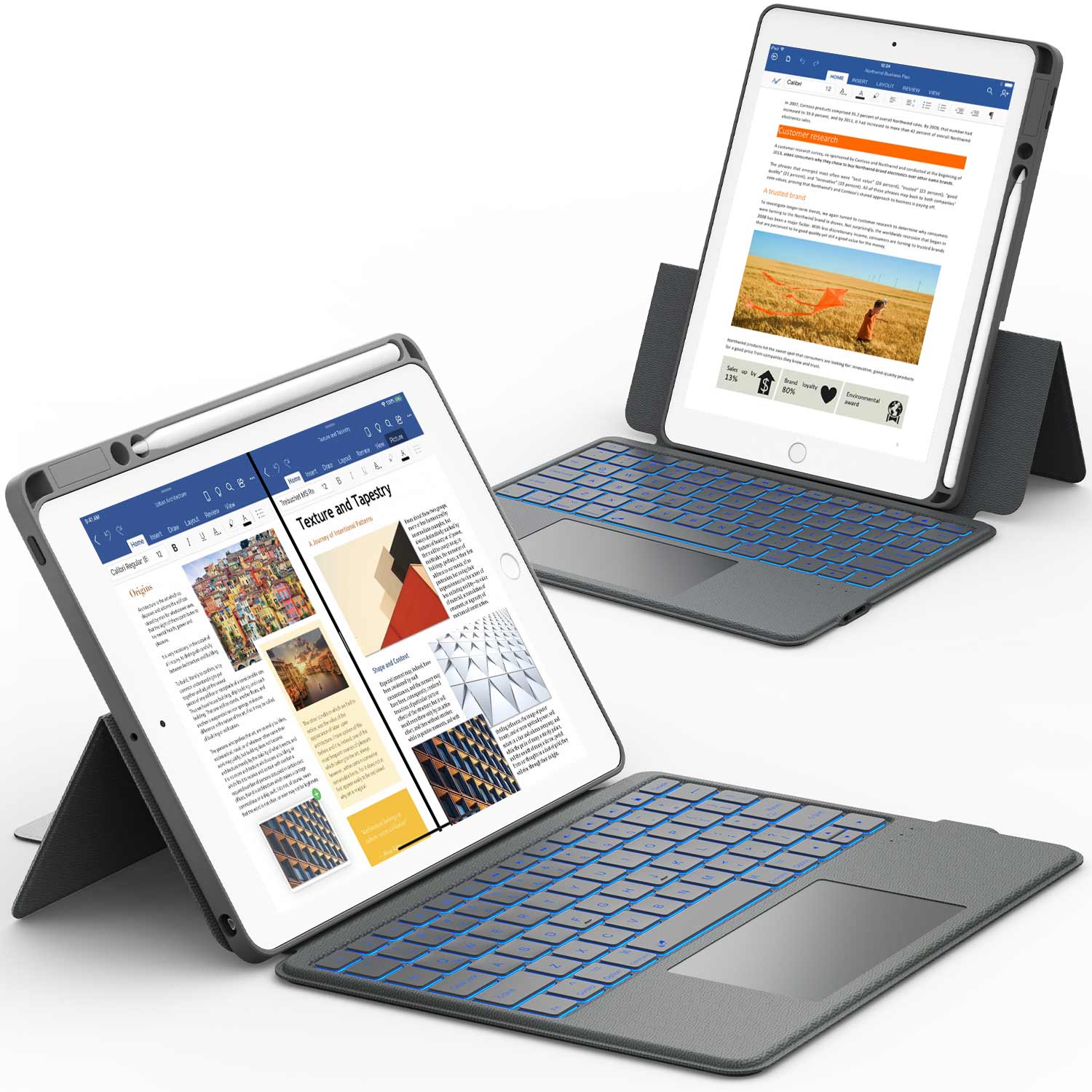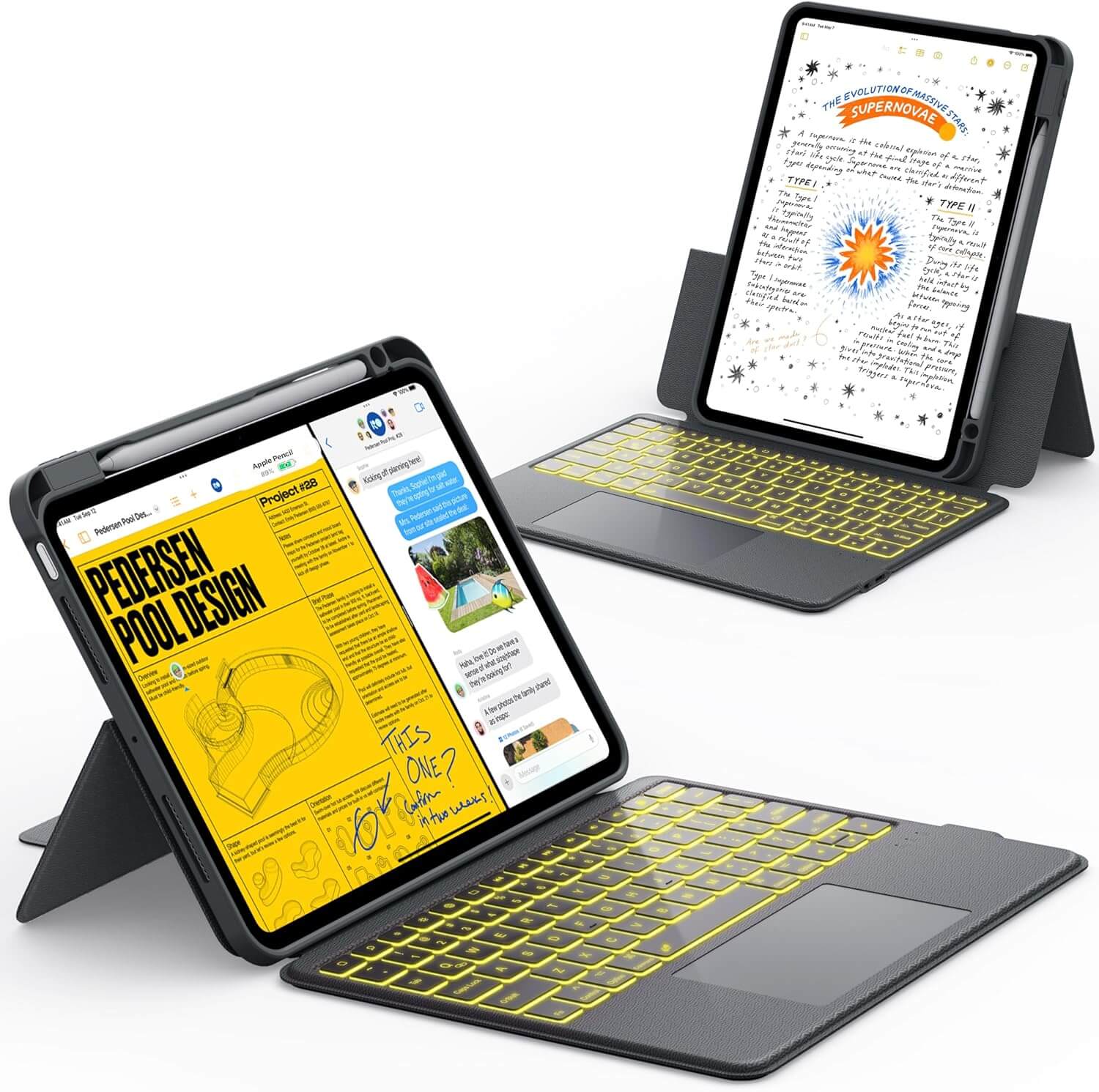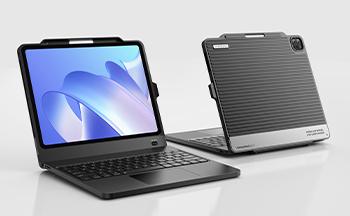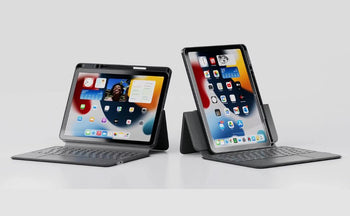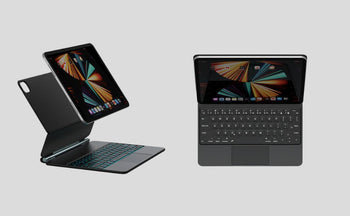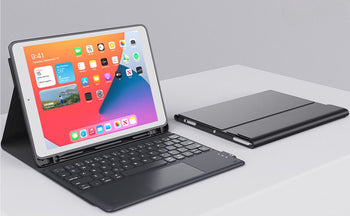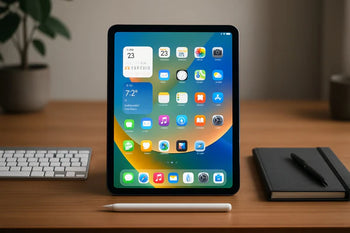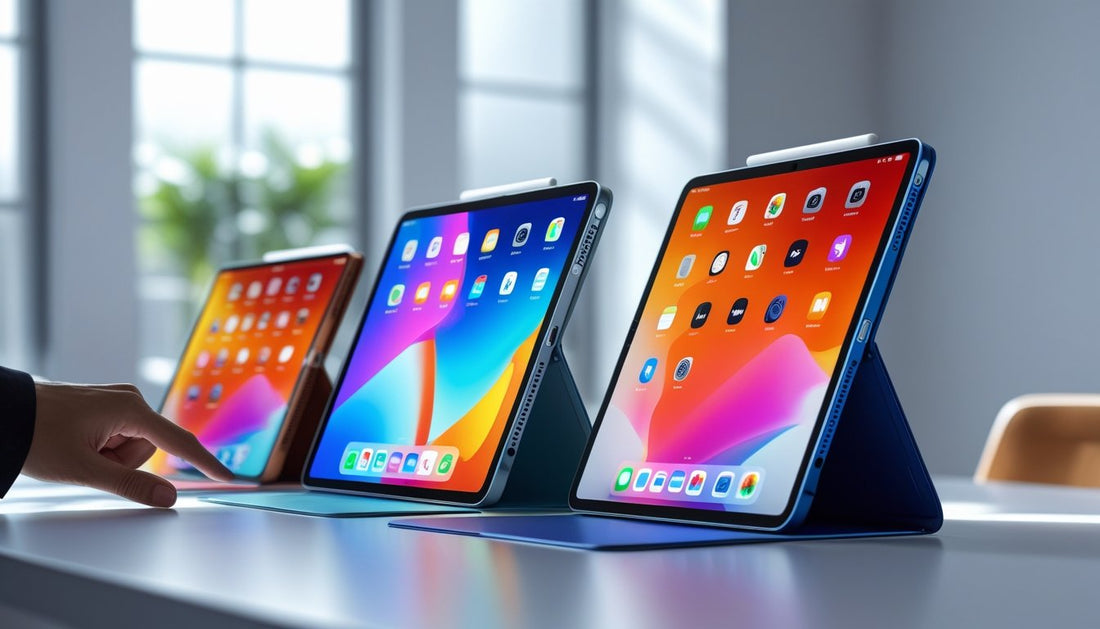The iPad Air generations have evolved a lot since the first model launched in 2013, offering users a perfect balance between performance, portability, and price. Each new release has brought design changes, faster chips, and better features that make the iPad Air a strong choice for students, professionals, and everyday users.
In this guide, we’ll walk through every iPad Air generation, highlight the key differences, and help you decide which version is the right fit for your needs. Whether you’re upgrading or buying your first iPad Air, this breakdown makes the decision easier.
Boost productivity on any iPad Air generation with a Keyboard Case. Type, work, and study with laptop‑like comfort.
Why the iPad Air Stands Out

The iPad Air nails a tricky balance: performance, portability, and price. It’s lighter and thinner than the standard iPad, but still picks up a lot of the advanced features from Apple’s higher-end tablets.
Its design is all about a slim frame, a laminated display, and colors that look true-to-life. That combo makes it pretty great for reading, streaming, or sketching—without feeling bulky.
Performance? That’s another big win. Chips like the A14 Bionic, M1, and now M2/M3 let you run demanding apps—video editors, drawing tools, you name it. And with iPadOS features like Split View and Slide Over, multitasking isn’t a headache.
Accessory support is a huge plus, too. The Air works with the second-gen Apple Pencil, Magic Keyboard, and USB-C accessories, so you can take notes, draw, or use it like a mini laptop.
Here’s a quick side-by-side with the standard iPad:
|
Feature |
iPad (10th Gen) |
iPad Air (M1/M2) |
|
Display |
Non-laminated |
Laminated, wide color |
|
Processor |
A14 Bionic |
M1 or newer |
|
Apple Pencil |
1st Gen |
2nd Gen |
|
Port |
Lightning/USB-C |
USB-C |
Those differences are why the iPad Air keeps winning over students, professionals, and anyone who wants a bit more than basic—without going all-in on the Pro.
How It Differs From iPad and iPad Pro

The iPad Air slots right between the standard iPad and the iPad Pro. It’s got more muscle and features than the base model, but doesn’t chase the Pro’s top-tier specs.
The standard iPad is all about affordability and simplicity. It’s good for browsing, watching videos, and lighter tasks. The Air steps it up with a faster chip, sleeker design, and a much better display—so it’s a better fit for creative stuff or heavier multitasking.
The iPad Pro is in a league of its own: faster processors, ProMotion 120Hz displays, more storage, Face ID, and pro-level graphics. It’s really aimed at folks who need it for design, video, or 3D work.
|
Model |
Key Strengths |
Typical Use Case |
|
iPad |
Affordable, simple, reliable |
Students, casual users |
|
iPad Air |
Balanced power and price |
Everyday use, light creative work |
|
iPad Pro |
High-end performance, features |
Professional and creative tasks |
The iPad mini is all about portability. It’s smaller and easier to toss in a bag, but you do lose some screen space for multitasking. If you want compact, it’s a good pick—but for most people, the Air is the better all-rounder.
Overview of All iPad Air Generations
To make things easier, here’s a table comparing every iPad Air generation at a glance:
|
Generation |
Year |
Display |
Processor |
Storage Options |
Apple Pencil Support |
Port |
RAM |
|
iPad Air (1st Gen) |
2013 |
9.7" Retina |
A7 |
16/32/64/128GB |
No |
Lightning |
1GB |
|
iPad Air 2 |
2014 |
9.7" Retina (laminated) |
A8X |
16/32/64/128GB |
No |
Lightning |
2GB |
|
iPad Air (3rd Gen) |
2019 |
10.5" Retina, True Tone |
A12 Bionic |
64/256GB |
1st Gen |
Lightning |
3GB |
|
iPad Air (4th Gen) |
2020 |
10.9" Liquid Retina |
A14 Bionic |
64/256GB |
2nd Gen |
USB-C |
4GB |
|
iPad Air (5th Gen) |
2022 |
10.9" Liquid Retina |
M1 |
64/256GB |
2nd Gen |
USB-C |
8GB |
|
iPad Air (6th Gen) |
2024 |
10.9" / 13" Liquid Retina |
M2 |
128/256/512GB/1TB |
2nd Gen |
USB-C |
8GB |
Protect your iPad Air in style with a slim Magnetic Case. Easy to snap on, lightweight, and perfect for daily use.
Key Differences Between iPad Air Generations
Each iPad Air generation brings its own tweaks in design, speed, and extras. These changes shape how the Air fits between the basic iPad and the Pro.
Design and Display Changes
The original Air (2013) was all about shedding weight and thickness. Later models kept trimming the bezels and lightening the load, so you can actually hold them for hours without getting tired.
Starting with the 4th gen, Apple switched to the Liquid Retina display—brighter, more colorful, better all around. Screen sizes went from 9.7 inches to 10.9, and now there’s even a 13-inch option in the latest models.
They also ditched the Lightning port for USB-C in the 4th gen, which is honestly a relief for anyone tired of dongles. Touch ID moved to the top button, letting Apple slim down the bezels even more.
No ProMotion or OLED, but for most people, the Air’s display is more than good enough.
Performance and Chip Upgrades
Every new Air gets a faster chip, so multitasking and app performance keep improving:
- 1st gen: A7
- 2nd gen: A8X
- 3rd gen: A12 Bionic
- 4th gen: A14 Bionic
- 5th gen: M1
- 6th gen: M2
RAM has gone up, too, making multitasking and iPadOS features like Split View way smoother. Once Apple put the M1 and M2 chips in the Air, it started getting close to Pro-level speed—enough for creative work, light pro tasks, and honestly, most people won’t need more power than that.
Wi-Fi and battery life keep getting better, even as the Air gets faster. That’s pretty impressive.
Camera and Accessory Support
Camera quality has gotten better with each iPad Air, but let’s be honest, it’s not the main reason people upgrade. The earlier Airs had pretty basic rear cameras. Newer models come with higher megapixel sensors and do a bit better in low light. Up front, the camera’s improved too—now you get Center Stage for smoother video calls, which is handy if you move around a lot.
Accessory support has really shaped the iPad Air’s appeal. The 3rd gen brought in the 1st‑gen Apple Pencil. Then the 4th gen switched to the 2nd‑gen Apple Pencil with magnetic charging—much more convenient. That’s also when Apple added Magic Keyboard support, so you could basically turn the Air into a mini laptop.
Apple’s move to USB‑C opened things up for external drives, displays, and all sorts of accessories. Cellular models keep getting faster, which is great if you rely on mobile data.
Price and Value Over Time
The iPad Air always lands between the entry‑level iPad and the Pro—kind of the sweet spot for most folks who want better specs and design but don’t need every Pro feature, like ProMotion or OLED.
Earlier Airs were priced closer to the basic iPad, but as Apple put M-series chips inside, the gap with the Pro shrank. The 5th and 6th gen models, with M1 and M2 chips, pack a punch for the price.
Apple bumped up storage options over time, starting at 64GB, then moving to 128GB. Sure, prices went up a bit, but you get more for your money now, and the Air feels more future‑proof.
|
Generation |
Release Year |
Chip |
Display Size(s) |
Accessory Support |
Camera Features |
Base Storage |
Ports |
|
iPad Air (1st gen) |
2013 |
A7 |
9.7" |
None |
5MP rear, 1.2MP front |
16GB |
Lightning |
|
iPad Air (2nd gen) |
2014 |
A8X |
9.7" |
None |
8MP rear, 1.2MP front |
16GB |
Lightning |
|
iPad Air (3rd gen) |
2019 |
A12 Bionic |
10.5" |
1st‑gen Apple Pencil, Smart Keyboard |
8MP rear, 7MP front |
64GB |
Lightning |
|
iPad Air (4th gen) |
2020 |
A14 Bionic |
10.9" |
2nd‑gen Apple Pencil, Magic Keyboard |
12MP rear, 7MP front |
64GB |
USB‑C |
|
iPad Air (5th gen) |
2022 |
M1 |
10.9" |
2nd‑gen Apple Pencil, Magic Keyboard |
12MP rear, 12MP front (Center Stage) |
64GB |
USB‑C |
|
iPad Air (6th gen) |
2024 |
M2 |
11", 13" |
Apple Pencil Pro, Magic Keyboard |
12MP rear, 12MP front (Center Stage) |
128GB |
USB‑C |
|
iPad Air (7th gen) |
2025 |
M3 |
11", 13" |
Apple Pencil Pro, Magic Keyboard |
12MP rear, 12MP front (Center Stage) |
128GB |
USB‑C |
Which iPad Air Generation Should You Buy?
The iPad Air lineup has changed a lot—new chips, displays, and accessory support with every update. Picking the right one really comes down to what you’ll use it for and your budget. There’s no one-size-fits-all answer here.
Best Option for Students
For most students, the iPad Air (6th generation, 2024) just makes sense. The M2 chip is quick enough for multitasking, note-taking, and apps like Office or Google Docs. You get 11‑inch or 13‑inch Liquid Retina displays—plenty of space for reading, writing, and even split-screen work. The bigger size can easily stand in for a lightweight laptop if you add a Magic Keyboard.
If you like taking digital notes, Apple Pencil Pro support is a game changer. Hover and pressure sensitivity make handwriting and drawing feel more natural. Battery life averages around 10 hours, which covers a full day of classes. And with 128GB to start, you won’t run out of room for files anytime soon.
Best Option for Creative Work
If you’re into design, video, or music apps, the iPad Air (6th gen) is a solid pick for most. The M2 chip handles photo editing, drawing, and light video projects without much fuss. Artists will appreciate the Apple Pencil Pro support, and writers or editors get a lot out of the Magic Keyboard.
But if you’re working with 4K video, 3D rendering, or heavy creative apps, you might hit the Air’s limits. In that case, the M4 iPad Pro is faster, has a 120Hz ProMotion display, and offers more storage—up to 2TB. For most creative folks who don’t need the absolute best, though, the Air hits a nice balance of price and power.
Best Budget‑Friendly Pick
Want the iPad Air experience without paying top dollar? Check out the iPad Air (5th gen, 2022). The M1 chip is still plenty fast for browsing, streaming, and most productivity apps. You get 2nd‑gen Apple Pencil and Magic Keyboard support, so it’s great for note-taking, sketching, or light creative work.
The 10.9‑inch Liquid Retina display looks sharp, but you don’t get the bigger screen option from the 6th gen. Prices are usually lower, especially from third-party sellers. It’s not quite as future-proof as the newer model, but for the money, it covers all the basics and then some.
Keep your iPad Air safe without bulk. Explore our Lightweight Cases designed for travel, school, and everyday carry.
Conclusion: iPad Air Generations
The iPad Air generations show just how much Apple has refined this device over the years, from a lightweight tablet in 2013 to a powerful tool that rivals laptops today. Each model has its strengths, and the right choice depends on what you need most—performance, portability, or price.
If you’re looking for a balanced iPad that can handle work, study, and entertainment, the latest iPad Air is a solid option. But if you’re still unsure which model best fits your needs, we’ve got you covered.
Check out our full comparison of iPad Air vs. iPad Pro to make the smartest choice.
Frequently Asked Questions
The iPad Air’s gone through a bunch of generations, each one bringing changes in design, performance, and software. Figuring out which model you have usually means checking the release year, iPadOS version, or hardware details.
How many iPad Air generations are there?
As of 2025, there are seven iPad Air generations. The first came out in 2013, and Apple’s kept the updates coming—new chips, displays, and better accessory support each time.
Which generation is iPad Air right now?
The latest is the iPad Air 7th generation (M3, 2025). You can get it in 11‑inch or 13‑inch, it runs iPadOS 26, and works with the Apple Pencil Pro.
Is the iPad Air Gen 6?
Yep, the iPad Air 6th generation is a real thing—released in 2022 with the M2 chip. It only came in an 11‑inch size, supported the 2nd‑gen Apple Pencil, but didn’t have Apple Pencil Pro support or a 13‑inch version like the 7th gen.
How do I know if my iPad Air is 4th or 5th generation?
If you’re not sure which one you have, just head to Settings > General > About and check the Model Number. You can also use Apple’s serial number lookup tool online. Notably, the 5th gen brings 5G support and the M1 chip, which is a pretty big leap from the A14 in the 4th gen. If your iPad feels zippy and you see 5G options, chances are it’s the newer model.
